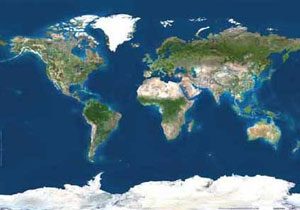
Plate tectonics: The world as seen from space (flattened out)
The continents move around
When you look at a map of the world, it seems as though it was always like that – North America on top of South America, Europe north of Africa, Australia off at the bottom right. But really all of the dry land on Earth moves around.
The Hadean eon
Summary of geological eras
All our geology articles
How do continents move?
The continents are like floating shapes about 60 miles thick on top of hot, mushy rock in the mantle – the hotter part of the Earth between us and the Earth’s iron core. Land masses move around the way bath toys move around in the bathtub. This happens on some other planets, too. The land masses move very slowly – usually no more than twenty centimeters in a year. More often 1-5 cm a year.
Other planets
The earth’s iron core
Like the bath toys, sometimes the land masses are all clumped together in one part of the Earth, and other times they drift apart. This has happened at least three times since the dry land masses first appeared on Earth about four billion years ago.
Earthquakes and volcanoes
When the land masses run into each other, or slide under each other, it causes earthquakes and volcanoes, and sometimes huge mountain chains, like the Alps or the Himalayas, get pushed up high above sea level.
The Himalayas
What are earthquakes?
How do volcanoes work?

Pangaea: all the land on earth clumped together
Rodinia supercontinent
Just over a billion years ago, all the land clumped together in one big land mass we call Rodinia. At this time there were only simple sea plants on Earth, and nothing much lived on land.
The Proterozoic Era
Seaweed and sponges
Pannotia supercontinent
Rodinia broke apart eventually, and then in the time of the first spiders and insects the land came back together again in another big clump we call Pannotia, about 500 million years ago, and then moved apart again.
The Cambrian period
Spiders and insects
Pangaea supercontinent
The most recent time that the land masses all clumped together was about 250 million years ago, during the time of the dinosaurs. We call this super-continent Pangaea (pan-JAY-ah). Then, about 180 million years ago, the land masses began to drift apart again, and they are still drifting away from each other today.
The Triassic period
More about dinosaurs
Laurasia and Gondwana
First Pangaea broke in half into two pieces, Laurasia and Gondwana. Then Laurasia broke up into North America, Europe and Asia. Gondwana broke up into South America, Africa, Antartica, and Australia.
If you look at the continents today, you can see how South America would have fit against Africa. About 55 million years ago, India broke off of Africa and smashed into Asia, creating the Himalaya mountains.
Still moving today
The land masses are still moving today. Thanks to plate tectonics, North America and South America are gradually moving away from Europe and Africa, so that the Atlantic Ocean is getting bigger and the Pacific Ocean is getting smaller. The California edge of the Pacific Ocean is ramming into North America and sliding past it, causing earthquakes in California and forming the Rocky Mountains.
The Rocky Mountains
In several hundred million years, the Pacific Ocean will shrink to nothing, and the West Coast of North America will smash into Japan and China, forming another large land mass, and probably another large mountain range.
Learn by doing: cut out the shapes of the continents in thick cardboard and move them the way the real continents moved.
More about geological eras
More about the Himalaya mountains
And more about the Earth’s core
Bibliography and further reading about plate tectonics:





